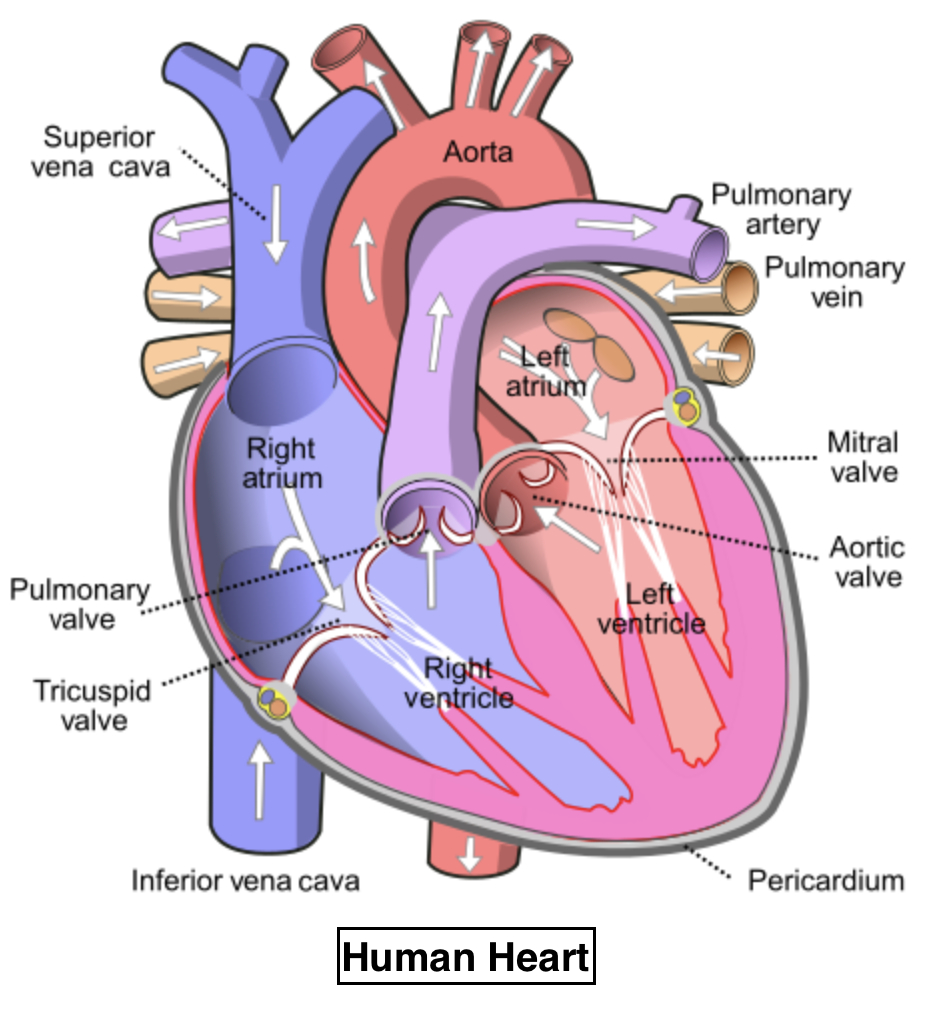
The valve present between the left auricle and left ventricle is
(a) Tricuspid valve
(b) Bicuspid valve
(c) Mitral valve
(d) Aortic valve
Answer
557.4k+ views
Hint: Human heart is a central muscular pressure pump, concerned with the collection, storage, and pumping of blood. The valve between the left auricle and ventricle permits blood to flow from the left atrium into the left ventricle, but not in the reverse direction. It has two flaps (cusps). It is so named because it looks like a bishop's miter.
Complete answer:
The Mitral valve is located between the left auricle and the left ventricle. Each auricle communicates with the ventricles of its side through an auriculo-ventricular aperture, guarded by an auriculo- ventricular valve. The right auriculo- ventricular valve has three cusps or flaps. So, it is called the tricuspid valve. On the other hand, the left one has only two cusps and hence called the bicuspid valve. The human heart is relatively smaller in size.

The human heart is a tetralocular or four- chambered organ, with two upper and lower chambers. Its upper chambers are called auricles and the lower one is called ventricles. Sinus venosus, found in lower vertebrates has become completely fused with the right auricle. So, it does not exist as a separate chamber.
Additional Information:
- Auricles are thin-walled, whereas ventricles are thick-walled and strongly muscular. Externally, auricles are separated from the ventricles below by a circular groove, called a coronary sulcus, and internally by the transverse auriculo- ventricular septum
- On the interauricular septum is an oval depression, called fossa ovalis. It corresponds to an opening of the fetal heart, called foramen ovale.
- The two auricles are separated from each other by an interventricular septum.
So, the correct answer is '(c) Mitral valve'
Note:
- Aortic valve is located between the left ventricle and the aorta.
- Leading from the right ventricle is the pulmonary artery that carries blood to the lungs. Arising from the left ventricle is the aorta whose branches supply blood to the different parts of the body.
- At the opening of the aorta and pulmonary artery is a set of three semilunar valves each, known respectively as aortic semilunar valves and pulmonary semilunar valves.
Complete answer:
The Mitral valve is located between the left auricle and the left ventricle. Each auricle communicates with the ventricles of its side through an auriculo-ventricular aperture, guarded by an auriculo- ventricular valve. The right auriculo- ventricular valve has three cusps or flaps. So, it is called the tricuspid valve. On the other hand, the left one has only two cusps and hence called the bicuspid valve. The human heart is relatively smaller in size.

The human heart is a tetralocular or four- chambered organ, with two upper and lower chambers. Its upper chambers are called auricles and the lower one is called ventricles. Sinus venosus, found in lower vertebrates has become completely fused with the right auricle. So, it does not exist as a separate chamber.
Additional Information:
- Auricles are thin-walled, whereas ventricles are thick-walled and strongly muscular. Externally, auricles are separated from the ventricles below by a circular groove, called a coronary sulcus, and internally by the transverse auriculo- ventricular septum
- On the interauricular septum is an oval depression, called fossa ovalis. It corresponds to an opening of the fetal heart, called foramen ovale.
- The two auricles are separated from each other by an interventricular septum.
So, the correct answer is '(c) Mitral valve'
Note:
- Aortic valve is located between the left ventricle and the aorta.
- Leading from the right ventricle is the pulmonary artery that carries blood to the lungs. Arising from the left ventricle is the aorta whose branches supply blood to the different parts of the body.
- At the opening of the aorta and pulmonary artery is a set of three semilunar valves each, known respectively as aortic semilunar valves and pulmonary semilunar valves.
Recently Updated Pages
Master Class 12 Business Studies: Engaging Questions & Answers for Success

Master Class 12 Economics: Engaging Questions & Answers for Success

Master Class 12 English: Engaging Questions & Answers for Success

Master Class 12 Maths: Engaging Questions & Answers for Success

Master Class 12 Social Science: Engaging Questions & Answers for Success

Master Class 12 Chemistry: Engaging Questions & Answers for Success

Trending doubts
What is meant by exothermic and endothermic reactions class 11 chemistry CBSE

Which animal has three hearts class 11 biology CBSE

10 examples of friction in our daily life

One Metric ton is equal to kg A 10000 B 1000 C 100 class 11 physics CBSE

1 Quintal is equal to a 110 kg b 10 kg c 100kg d 1000 class 11 physics CBSE

Difference Between Prokaryotic Cells and Eukaryotic Cells




